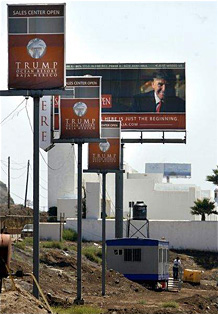 |
 |
 |
 Puerto Vallarta Real Estate | December 2007 Puerto Vallarta Real Estate | December 2007  
Baja Feels the Effects of US Housing Downturn
 Diane Lindquist - San Diego Union-Tribune Diane Lindquist - San Diego Union-Tribune
go to original


| | Interest in the Trump Ocean Resort Baja is strong, according to a project spokesman who said a June sales event yielded $45 million in contracts in just five hours. Still, some Baja real estate veterans worry that other projects will fold. (Los Angeles Times) |
Carlsbad – The U.S. housing slump has spread south across the border, dampening a coastal real estate boom boosted in recent years by Americans snatching up vacation and retirement homes in Baja California and elsewhere in Mexico.

How long the downturn will last dominated much of the conversation at yesterday's Mexican resort development conference at La Costa Resort and Spa. The event, sponsored by the Baker & McKenzie law firm and Sausalito-based Contact Development, drew about 400 attendees on the first day. It ends today.

Developers and financial executives speculated that the slump in Mexico will continue for anywhere from six months to two years – or perhaps even five years.

About 30 resort and housing projects that had been planned in northern Baja California and Puerto Peńasco on the Sea of Cortez in Sonora, south of Arizona, won't get built, predicted Embree “Chuck” Bedsole, managing director of the global advisory firm Alvarez & Marsal.

“There is a lot of supply in the pipeline,” he said. “We've been debating whether that's going to be developed.”

Until recently, before prices fell and became more volatile, appreciation rates on Mexican property had reached 15 percent annually. That's expected to drop to 5 percent to 10 percent during the slowdown.

Unlike the housing market meltdown in the United States, which has been partially caused by young first-time buyers failing to make payments on their adjustable-rate mortgages, the Mexican slowdown is more associated with baby boomers who pulled equity out of high-priced property to buy retirement or vacation homes in a sunny climate. The condos, townhomes and houses range in price from $150,000 to more than $1 million.

The boomers' monetary shortfalls are more temporary, the experts said, because they have more equity and are inheriting money as their parents pass away.

“Baby boomers have a lot of wealth. You've got a lot of people who are going to have time and money to do stuff,” said Textron Financial senior vice president Adam Greene. “The feeling is there's a lot of money waiting on the sidelines.”

Over the past decade, the number of such buyers settling into active-lifestyle communities in Mexico has increased from 200,000 to between 600,000 and 1 million. About 100,000 U.S. citizens retire to Mexico each year.

Property sold in Mexico also tends to be in the luxury category and, thus, more immune to impacts from the current U.S. housing situation.

“There's a temporary downturn in sales,” said John McCarthy, chief executive of Mexico Leisure Real Estate Development Partners, “but I think the demographics are there. And once the psychological effect of the subprime crisis passes, the market will come back.”

The “Gold Coast” corridor from Tijuana to Ensenada could lag behind other areas in recovery, said Bruce Greenberg, who heads an Arizona real estate appraisal and consulting firm. He said the region's developers tended to be smaller developers and builders who came across the border.

“Two guys with cell phones” was the description offered by Justin Mehren, managing director of Latin America Capital Group.

The current slowdown will spur a better quality of development, said the experts. Mixed-use projects that anchor lodging with shops, restaurants, attractions and entertainment will attract funding that is available, several said.

“Diverse planning is needed. And there's a need to integrate with tourism,” McCarthy said. “We need to give people more to do than just go to their condos and watch the sunset.”

The most popular and lucrative projects now are those that are branded, such as golf courses designed by champion golfer Jack Nicklaus, who spoke yesterday about his role as the top golf course architect in Mexico.

“As soon as golf became part of the equation, prices went up,” he said. “A branded golf course will boost the value and income of a resort.”

Diane Lindquist: (619) 293-1812; diane.lindquist(at)uniontrib.com | 
 | |
 |



